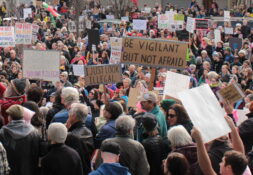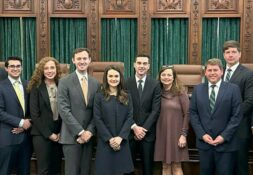COVID-19 has changed everything. How does it impact the 2020 presidential race?
Amid the COVID-19 pandemic, governments at every level have been grappling with the fact that polling places throughout the country may not be safe for the millions of citizens who will choose, among other things, the next President of the United States on November 4. Many normal activities for the election season, including in-person campaign events and large party conventions, have been scaled back or cancelled as the country struggles to contain the disease. Even Notre Dame has taken several measures to eliminate possible transmission vectors of COVID-19 as the institution navigates a return to in-person instruction. One of these has been reducing the number of visitors coming to campus by cancelling prospective student tours. More prominently, Notre Dame has withdrawn from hosting the first presidential debate.
Last October, the university announced that it would be the host venue for the first of the three customary debates between the Democratic and Republican presidential nominees. The event, originally scheduled for September 29, 2020, would have brought a surge of visitors to campus, including media personnel from around the world and campaign staffers. On July 27, Notre Dame President John Jenkins announced that the university would withdraw from hosting the debate, citing the “constraints the coronavirus pandemic put on the event.” On the same day, Case Western Reserve University announced that it would host the debate, albeit on its Health Education Campus, a product of a joint effort with Cleveland Clinic, in an effort to maintain a safe, healthy environment.
COVID-19 is truly the defining issue of this year, and its effects, ranging from the economic to the social, political, and even spiritual, will have a drastic impact on this country and the world for years to come. In the face of the many challenges caused by the pandemic, one of the most pressing matters that must be addressed is how exactly to conduct the election process this November in a safe and efficient manner. With social distancing measures in place, lines at polling centers around the country are sure to be extremely long. Thus, one solution has been presented as an alternative method for voters to cast their ballots: mail-in voting.
According to the New York Times, 76 percent of American citizens are eligible to vote by mail. In most states, one can request an absentee ballot without providing a reason, while in others, such as Oregon and California, a ballot will be mailed to all registered voters regardless of their absentee request. Only eight states, including New York and Texas, require a reason to be provided before a voter can receive an absentee ballot.
Mail-in voting has long been approved of by citizens of all political stripes. A Gallup poll conducted in May found that 64 percent of Americans favored allowing all voters to vote by mail in the 2020 election, compared to 34 percent who opposed such an allowance. However, a partisan split still remains on the issue: while 83 percent of Democrats and 68 percent of independents supported universal mail-in voting, only 40 percent of Republicans said the same.
President Trump, for his part, has publicly opposed a move to allow universal mail-in ballots, writing in a July 30 tweet: “With Universal Mail-In Voting (not Absentee Voting, which is good), 2020 will be the most INACCURATE & FRAUDULENT Election in history. It will be a great embarrassment to the USA.” He later suggested in the same tweet that the election should be delayed “until people can properly, securely and safely vote.”
Despite President Trump’s objections, the reality of widespread mail-in ballots means that election results will be delayed, possibly for weeks after November 3, which will undoubtedly sow discord and confusion into an already tumultuous election season.
Major party conventions— another mainstay of election-year politics— have also been impacted by the coronavirus pandemic. Though the Democratic National Convention was originally slated to take place in Milwaukee, Wisconsin, the Democrats opted for a mostly virtual event, with major speakers giving their keynotes remotely. Former Vice President Joe Biden accepted his party’s nomination for President on August 20, the final night of the convention.
The Republican National Convention followed a week later. President Trump accepted his renomination with a 70-minute speech to an in-person audience and attacked Biden for past failures, saying that the former Vice President “is not a savior of America’s soul. He is the destroyer of America’s jobs, and if given the chance, he will be the destroyer of America’s greatness.”
Regardless of who eventually emerges as the victor, there is no doubt that this November’s election will be unlike any other in the history of the United States.
Luke Koenigsknecht is a sophomore from Grand Rapids, Michigan studying electrical engineering. In his spare time, he enjoys reading as well as playing games or solving puzzles. He also fancies himself an amateur baker. He can be reached at lkoenigs@nd.edu.






Leave a Reply